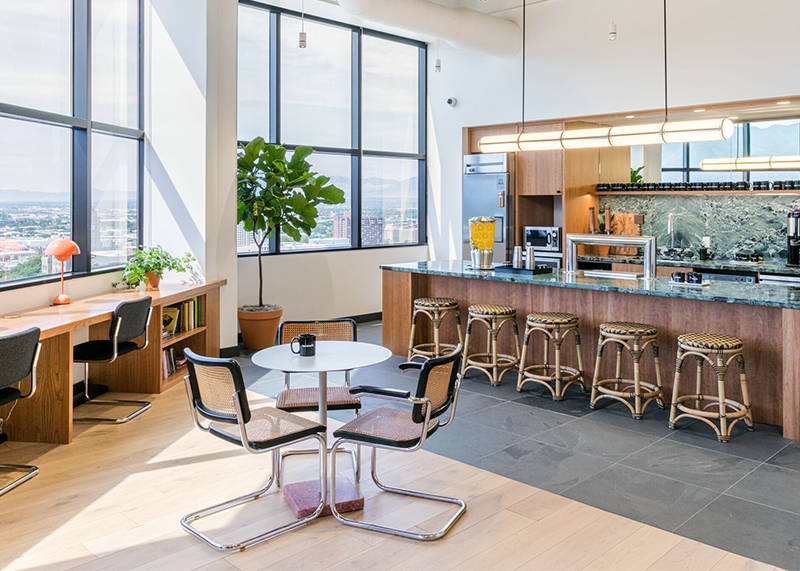A standard commercial property lease can be overly restrictive, especially for smaller businesses and startups. If you’re looking for flexibility, you need shorter lease terms and rentable office spaces that fit your team size – both of which can be difficult to negotiate directly with a property owner. This is where commercial sublease agreements can come in handy.
Commercial sublease agreements have a wide range of applications in both retail and office space settings. You’ll often see them in the form of pop-up shops and restaurants, where existing or unused retail space is temporarily rented out to new artists, designers and emerging brands to attract customers and reduce overhead.
In offices, a commercial sublease agreement allows departing tenants to cover some of the outstanding rental fees owed to the property owner until their lease expires. They’re also commonly used when a tenant is downsizing and wants to sublease a portion of the office to another company.
The future of work is flexible, and commercial subleases are one way for smaller businesses and startups to capitalise on that idea.
This article is part of our wider guide to understanding commercial property. Here, we’ll discuss the basics of commercial subleases, whether they’re a good idea for your business, and some of the risks and benefits involved. But first, let’s nail down precisely what we mean when we talk about a commercial sublease.
What is a commercial sublease?
A commercial sublease is an agreement to lease space from a tenant rather than directly from a property owner. If the new tenant (the sublessee) is taking over a space that’s being vacated, they often have the option to directly lease the space when the lease is up. In other cases, both tenants will share the space until one or both decides to move on.
When does subleasing make sense?
For the tenant leasing the office space, subleasing to another business is a way to reduce monthly costs or avoid the punitive termination fees that come with ending a contract early. For the landlord, commercial subleases allow a trusted tenant to subdivide a property among small businesses, guaranteeing a rental income on the whole building while avoiding the hassle of having to deal with multiple tenants.

For businesses looking for shared office space, a commercial sublease is an opportunity to find affordable space on highly flexible lease terms. Commercial leaseholders are motivated to find new tenants quickly, so subleases are generally cheaper than dealing directly with a landlord. The flexible terms of a commercial sublease are also suited to smaller companies and startups that don’t need lots of space or might only require a short-term lease.
Commercial subleasing pros and cons
As with any kind of lease, there are benefits as well as potential drawbacks to subleasing shared office space from another individual or company.
These are some of the upsides of a sublease.
- It’s cheaper. As they’re usually part of a larger office, subleased spaces are more cost-efficient to rent. You can save money on shared expenses such as Internet, utilities and security, and you may not be required to contribute to the maintenance and upkeep of common areas, toilets and lifts – something that is especially important now, as buildings are rolling out enhanced cleaning and social distancing measures.
- You can negotiate access to shared space and equipment. As a sublessee, there’s no need to purchase expensive items such as copiers and printers, as your sublessor will probably already have these on-site. Access to conference rooms, kitchens and other shared areas can also be negotiated as part of your monthly rent.
- You can enjoy more choice and variety. Subleasing opens up the doors to many smaller shared office spaces in a wider variety of locations and over much shorter terms, which is ideal for smaller companies or those just starting out.
It’s also important to take these disadvantages into consideration when negotiating with a sublessor to ensure that you know your limitations as a sublessee.
- You can’t modify the space. Most commercial subleases are rented out ‘as is’, meaning you won’t have the same freedom to adapt or change the layout of the space to suit your needs as you would if you were leasing directly from the property owner.
- You’re subject to the underlying lease. You’ll be bound by the terms of your sublessor’s agreement with their landlord as well as the terms of your own sublease, so make sure you understand and agree to both.
- Maintenance and repairs can take longer. The more people standing between you and the individual responsible for handling building repairs, the more delays you can expect if something goes wrong.
Are there risks for sublessees?
As with any business deal, there are some risks involved when entering into a commercial sublease agreement. Many of these relate to the fortunes of the individual or company handling your sublease.
For example, if your sublessor defaults on their lease agreement with the property owner, the landlord typically has the right to evict you regardless of whether or not you’ve been meeting the obligations of your sublease. You can protect against this by negotiating a ‘right to cure’ clause, which allows sublessees to pay rent directly to the landlord if the sublessor defaults.
The property owner may also have the power to void the contract if they take issue with the terms of your sublease or the kind of business you operate. This is why it’s vital to have a thorough understanding of the terms of the underlying lease, as well as the financial situation of your sublessor, before entering into negotiations. If your sublessor isn’t willing to share these records, this could be an indication that they aren’t confident in their ability to meet the obligations of their own lease.
How to create a commercial sublease agreement
There are a number of commercial sublease agreement templates you can find online, including this example agreement from LawDepot. If you’re uncertain about the finer details, or if your sublease requires some non-standard terms, it’s wise to enlist the help of a lawyer or commercial property broker to finalise the process.

Prepare all of the information required to form the sublease agreement ahead of time, including the names of all parties involved, the start and end dates of the subtenancy, the amount of the rent and other miscellaneous fees. A commercial sublease agreement also requires written consent from the property owner for the space to be sublet. This can take a while to complete, so request it as early in the process as you can.
As a side note: by this stage, you should have created an LLC to protect yourself and your business from the various personal liabilities involved with lease agreements.
Using flexible leases with WeWork instead of a commercial sublease
Finding the perfect office space for your team to meet your financial needs and inspire your best work can be a daunting task, particularly if you’re searching for short leases and flexible terms. At WeWork, you can skip the headache of negotiating a traditional commercial sublease and concentrate on finding shared office space that meets the needs of your company.
There’s a reason WeWork is considered the workplace of tomorrow. No matter how large or small your business, you can find beautifully designed and professionally managed offices in cities around the world, allowing your team to adapt at its own pace, with the scale and flexibility to do what they do best.
Steve Hogarty is a writer and journalist based in London. He is the travel editor of City AM newspaper and the deputy editor of City AM Magazine, where his work focuses on technology, travel and entertainment.







